Who doesn’t like to win games quickly? When we talk about openings, we always see that we must develop our pieces, get the king safe and control the center. But when one of the players neglects the principle of getting the king to safety, some tragedies can happen, ending the game very quickly. Today we’re going to look at some miniatures and traps that lead to mate in the opening, and hopefully, you’ll end up using these patterns in your games!
I’m going to assemble this article in the form of an interactive puzzle, so try to find mates in the diagrammed positions!
Fool´s mate
It’s known as madman’s mate because only a madman can play that way! Additionally, this is the fastest mate that can occur in chess, needing only 2 moves to complete.
Boruchovsky, Nicolas-Koltanowski, George
BEL-ch02 Antwerp (9), 09.1922
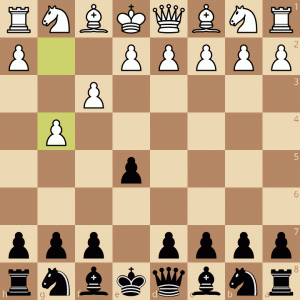
And of course, white can also make this pattern, as we can see below:
Oreskovic, Andelko (1671) – Riha, Alexander (2103)
Wattens op 15th Wattens (6), 31.08.2000
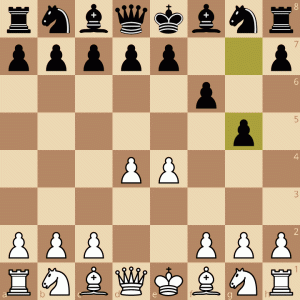
Apprentice’s Mate
This is very typical of those who are learning to play, and also end up making catastrophic plays:
Gritchuk, Ivan – Skrypin, Ivan
UKR-ch U08 Evpatoria (8), 16.05.2007
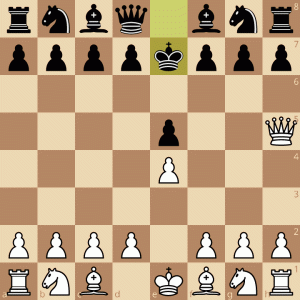
Roehr, Oliver (1671) – Roehr, Tobias (2065)
Rostock SSC op 16th Rostock (1), 26.07.2017

Scholar’s Mate
This is one of the most popular mates at the school level, and it also highlights an important thing in the opening: The weakness of the f2 and f7 squares, as they are only defended by the king, they are the weakest squares at the beginning of the game.
Scekaciov, Rostislav (1554) – Kosevoj, Egor
Klaipeda Rooks Cup Klaipeda (1), 07.04.2019
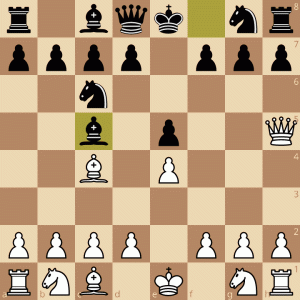
Lacouth, Antonio Felipe Pere – Carvalho, Eduardo Meireles
Rondonienses-ch Porto Velho (6), 11.17.2018
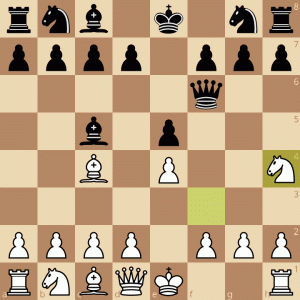
The Claustrophobic King
Basically, this mate can happen if you leave your king with no room to move:
Kordel, Mathias – Richter, Kurt (2120)
Dortmund Sparkassen vs Dortmund, 1998

Rapport, Richard (2701) – Rogers, Timothy (2011)
Politiken Cup 36th Helsingor (1), 21.07.2014

The Queen and the Knight going for a ride
Another good teamwork, showing the fragility of the f2/f7 squares in the opening:
Skambraks, Patrick-Froehlich, Kathrin
Schleswig Holstein-ch U10 Neumuenster (6), 11.04.2001

Cohen, Vincent-Van Splunter, Jacco
NED-ch U12 Hengelo (3), 08.08.2000
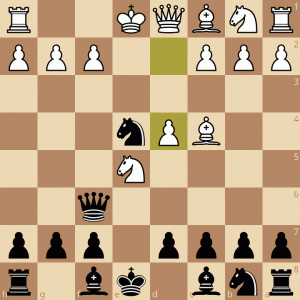
Don’t forget the h5-e8 diagonal… (or h4-e1)
This is a fatal diagonal, but we often end up weakening this diagonal, and it’s no wonder that the f7/f2 squares are part of it. See the dangers of leaving this diagonal exposed:
Menendez Villar, Jesus – Baragano Campa, David
San Agustin op 05th Aviles (2), 19.08.2000
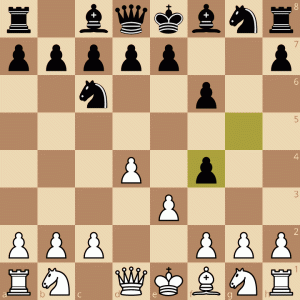
Lemieux, Denis (1475) – Menard, Marc (1417)
Gatineau Benevoles-C Gatineau (3), 23.09.2014
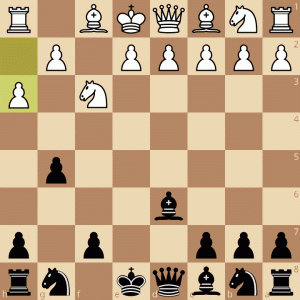
Legall mate
Another typical pattern, is named after the French player Legall de Kermeur, who applied this idea to a casual game in a French café. The idea is to move a pinned knight, and explore the f7/f2 square, as we will see:
Bjarnason, Oskar (2163) – Dittler, Volkfried
Bad Woerishofen op 17th Bad Woerishofen (8), 22.03.2001

Abdala, Juvino (1584) – Farias, Robson da Costa (1845)
Porto Velho Taca Porto Velho (5.2), 18.08.2013
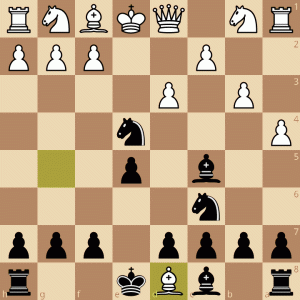
Sacrifice of destruction
Going back to the weakness of the h5-e8/h4-e1 diagonals, sometimes we can further weaken this diagonal in brute force, based on sacrifice:
NN – Du Mont
Paris Casual Games Paris, 1802

Pastukhov, Igor (2278) – Grass, Christian (1450)
Yuzhny op Yuzhny (1), 08.09.2009
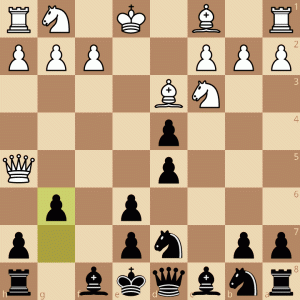
The Blackburne Trap
Is it a line from the Italian opening that appears on the board after 1.e4 e5 2.Nf3 Nc6 3.Bc4 Nd4?!
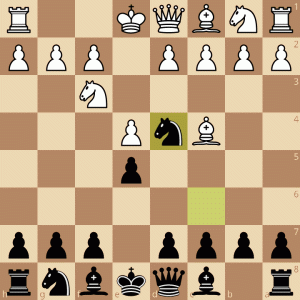
But if we put it on paper, moving the same piece more than once goes against the basic principles in the opening, and for example, after 4.O-O white has a superior position. However, why couldn’t White take the appetizing pawn on f7, gaining material and threatening a fork on f7? That’s exactly what Black wants!
4.Nxe5? Qg5 5.Nxf7 Qxg2 6.Kf1 Qxe4+ 7.Be2
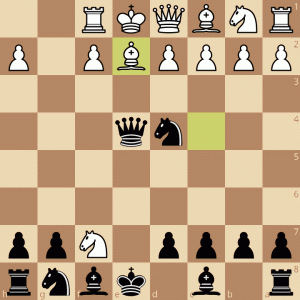
Party in the opposing castle
We have seen that when we are in the opening, the weakest point on the board is the f7/f2 square, as it is only defended by the king. But when the king castles, many times another point is weakened: the h7/h2 square, so even with the castled king, we need to be careful! Let’s look at some examples:
Heym, Alexandra (1206) – Mitze, Teresa (767)
GER-chT U20 Girls Chemnitz (4.3), 28.12.2009

From Francisco, Alec – Tabola, Lennard (796)
Bad Soden U10 op Bad Soden (1), 03.10.2019

Answers
1 – 2…Qh4#
2 – 3.Qh5#
3 – 3.Qxe5#
4 – 3…Qxe4#
5 – 4.Qxf7#
6 – 4…Qxf2#
7 – 5…Nd3#
8 – 5.Nd6#
9 – 5.Qxf7#
10 – 5…Qxf2#
11 – 5.Qh5#
12 – 5…Bg3#
13 – 6.Bxf7+ Ke7 7.Nd5#
14 – 6…Bxf2+ 7.Ke2 Nd4#
15 – 5…Bxg3+ (or 5…Qxg3+ 6.hxg3 Bxg3+) 6.hxg3 Qxg3#
16 – 8.Bxg6+ (or 8.Qxg6+ hxg6 9.Bxg6#) 8…hxg6 9.Qxg6#
17 – 7…Qxe4+ 8.Be2 Nf3#
18 – 7.Qxh7#
19 – 7…Qxh2#
Conclusion
We saw that all these examples show how risky it is not to defend our king in the opening and now that you know all these patterns, it will be a piece of cake to recognize them during your games, and more importantly: Don’t make these mistakes. And if you liked this article, you’ll like this one too! I hope that you enjoyed it!
Follow us on Facebook!
Join our club on chess.com!